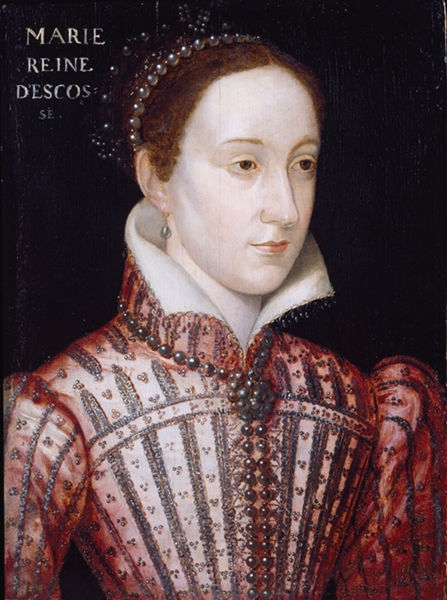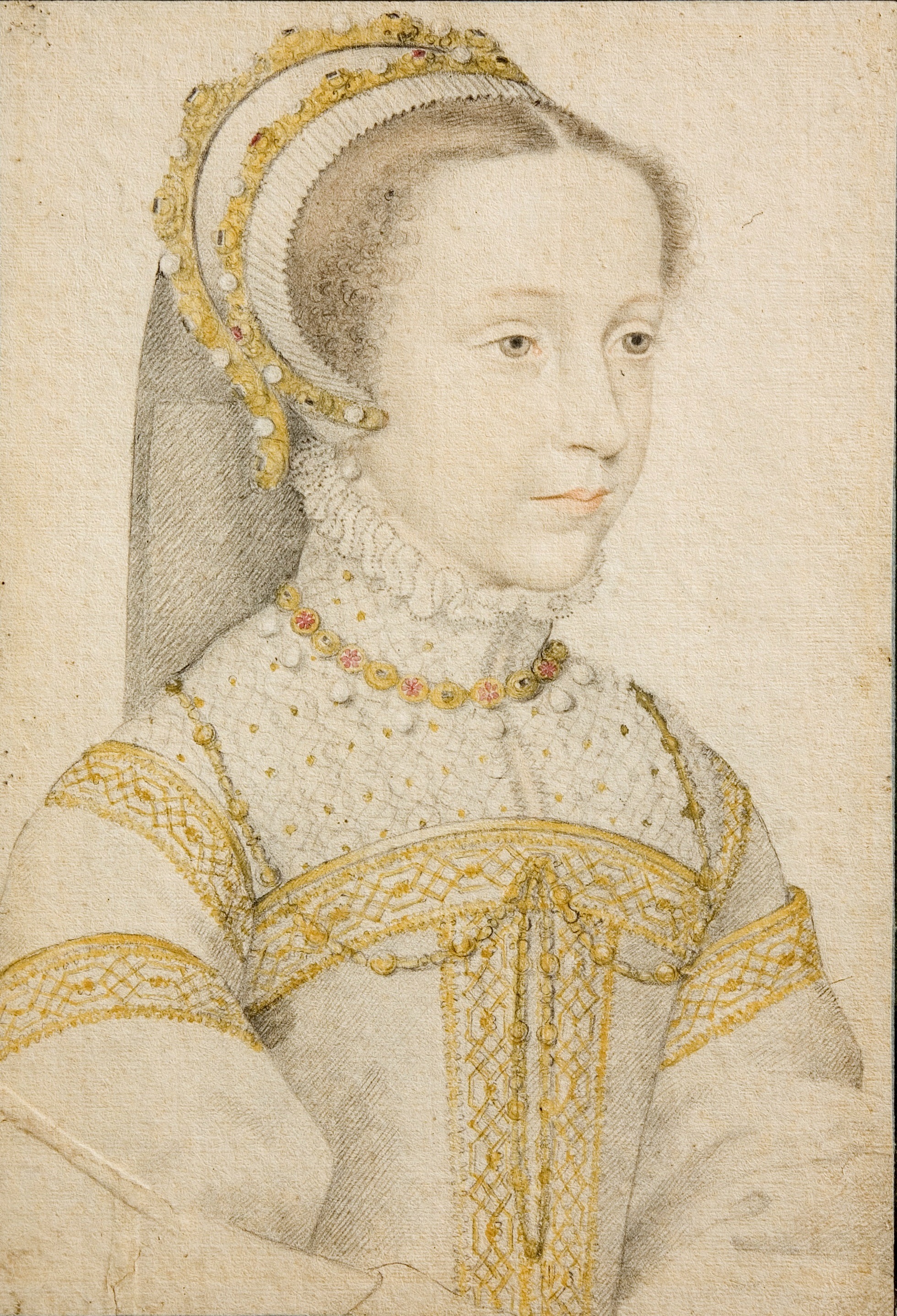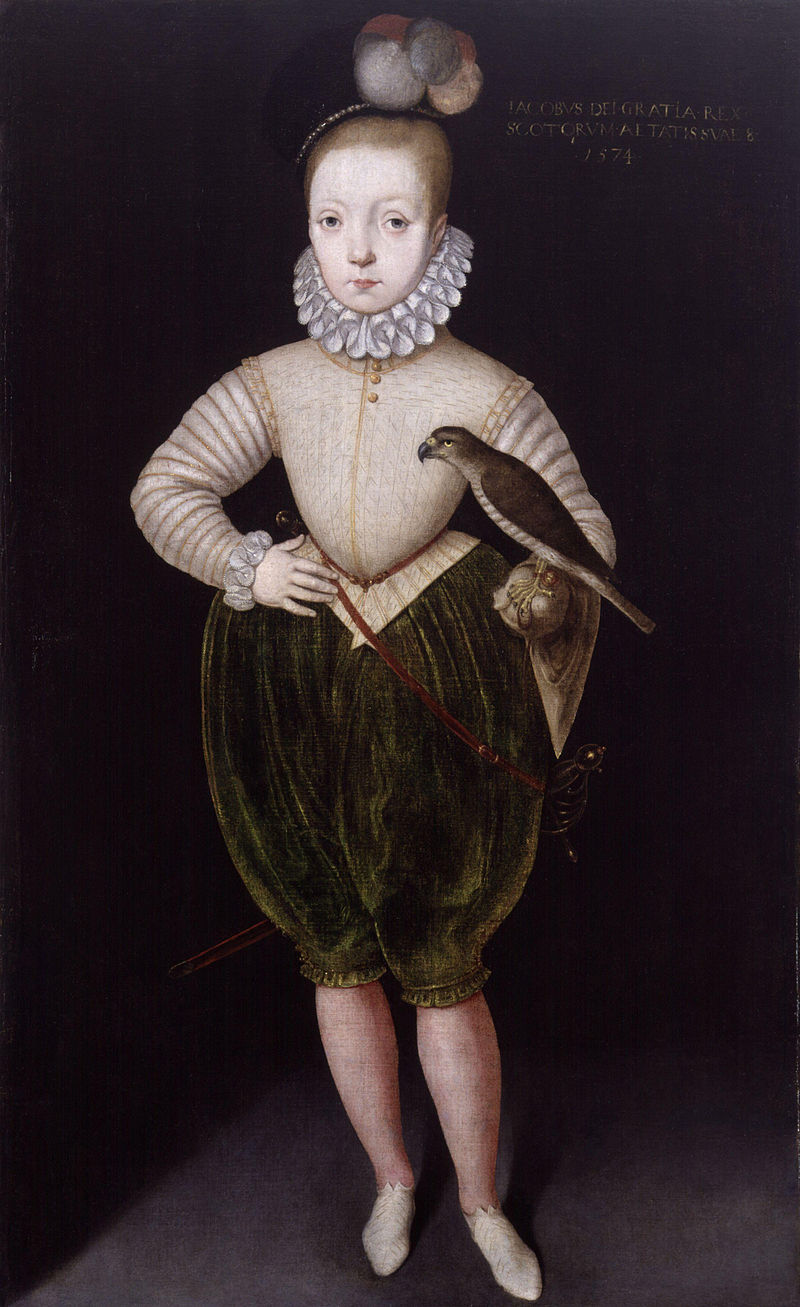by Susan Flantzer © Unofficial Royalty 2016

Mary, Queen of Scots by François Clouet, circa 1559
Mary, Queen of Scots was born on December 8, 1542, at Linlithgow Palace in Scotland. She was the third and the only surviving child of James V, King of Scots and his second wife Marie of Guise, a French princess. Mary’s paternal grandparents were James IV, King of Scots and Margaret Tudor, the daughter of King Henry VII of England and the sister of King Henry VIII of England. Her maternal grandparents were Claude of Lorraine, Duke of Guise, head of the House of Guise, and Antoinette de Bourbon.

Mary’s parents, King James V of Scotland and Marie of Guise; Credit – Wikipedia
Mary had two brothers who died in infancy:
- James, Duke of Rothesay (1540 – 1541)
- Arthur, Duke of Albany (born and died April 1541)
Mary had nine half-siblings via her father’s mistresses:
-
- James Stewart, Commendator of Kelso and Melrose (circa 1529 – 1557), son of Elizabeth Shaw
- John Stewart, Lord Darnley (circa 1531 – 1563), son of Elizabeth Carmichael
- James Stewart, 1st Earl of Moray (circa 1531 – 1570), son of Margaret Erskine, James V’s favorite mistress, adviser to his half-sister, Mary, Queen of Scots and regent for his nephew, James VI, King of Scots
- James Stewart (born and died circa 1532) died in infancy, son of Christine Barclay
- Robert Stewart, 1st Earl of Orkney (1533 – 1593) son of Euphame Elphinstone
- Adam Stewart, Prior of Perth Charterhouse (circa 1535 – 1575), son of Lady Elizabeth Stewart
- Jean Stewart (died 1588), daughter of Elizabeth Bethune
- Robert Stewart, Prior of Whithorn (died 1581), mother unknown
- Margaret Stewart, mother unknown
Mary also had two half-brothers from her mother’s first marriage to Louis II d’Orléans, Duke of Longueville:
- François III d’Orléans, Duke of Longueville (1535 – 1551), unmarried
- Louis d’Orléans (born 1537), died young
The year before Mary’s birth, her grandmother Margaret Tudor died and her father James V saw no reason to keep the peace with England. When war broke out between England and France in 1542, it was inevitable that Scotland would go to war against England because of their treaty with France. When Henry VIII of England broke from the Roman Catholic Church, he asked James V of Scotland, his nephew, to do the same. James ignored his uncle’s request and further insulted him by refusing to meet with Henry VIII at York.
Furious, Henry VIII sent troops against Scotland. In retaliation for the English raid into Scotland, James raised an army and attacked England. On November 24, 1542, the Battle of Solway Moss in Cumberland, England resulted in a decisive English victory. After the Battle of Solway Moss, James V fled to Falkland Palace in Scotland where he became ill and took to his bed. Overcome with grief and shame about the Battle of Solway Moss, James V lost the will to live. The news that Marie of Guise had given birth to a daughter on December 8, 1542, did nothing to raise his spirits. James V, King of Scots died at Falkland Palace in Fife, Scotland on December 14, 1542, at the age of 30, and was succeeded by his only surviving, legitimate child, six-day-old Mary.
James Hamilton, 2nd Earl of Arran, a great-grandson of James II, King of Scots and the heir to the Scots throne, became Regent. On September 9, 1543, Mary was crowned at Stirling Castle. Mary’s great uncle King Henry VIII of England tried to force an agreement of marriage between Mary and his six-year-old son the future King Edward VI of England to create a new alliance between England and Scotland. Scotland had an alliance with France called the Auld Alliance. When Scotland resisted, Henry VIII declared war resulting in an eight-year war known as the Rough Wooing (1543 – 1551). Because of the English hostilities, Scotland abandoned the possibility of an English marriage. In July 1548, the Scottish Parliament approved Mary’s marriage to François, Dauphin of France, the son and heir of King Henri II of France and Catherine de’ Medici.
On August 7, 1548, five-year-old Mary, Queen of Scots set sail for France where she would be raised with her future husband. She would not return to Scotland for thirteen years. Mary’s mother stayed in Scotland, but Mary was accompanied by her own court including John Erskine, 5th Lord Erskine, two of her illegitimate half-brothers, and the “The Four Marys”, four girls her own age, all named Mary, who were the daughters of Scottish nobles: Mary Beaton, Mary Fleming, Mary Livingston, and Mary Seaton. Also accompanying Mary was Janet Stewart, Lady Fleming, the mother of Mary Fleming and an illegitimate daughter of King James IV of Scotland, who was Mary’s governess.

Mary, Queen of Scots, at the age of 12 or 13 by François Clouet, circa 1555–1559; Credit – Wikipedia
Mary’s education was completed in France where she studied French, Greek, Italian, Latin, and Spanish along with music, dancing, singing, drawing, and needlework. Antoinette de Bourbon, Duchess of Guise, Mary’s maternal grandmother, had a great influence on her granddaughter and was one of her principal advisors. On April 24, 1558, Mary married François, Dauphin of France outside Notre-Dame Cathedral in Paris. In November 1558, Catholic Queen Mary I of England died and was succeeded by her Protestant half-sister Queen Elizabeth I. King Henry VIII’s will excluded the descendants of his sister Margaret from the succession. However, many Catholics considered Mary to be the rightful heir to the English throne.
On June 30, 1559, King Henri II of France was mortally wounded in a jousting match. He died on July 10, 1559, and Mary’s husband succeeded his father as King François II of France. François was crowned at Rheims Cathedral in September 1559. However, Mary did not participate in the coronation as she was already an anointed and crowned queen.

King François II of France and his wife Mary, Queen of France and Queen of Scots; circa 1558
After only a 17-month reign, François, aged 16, died in great pain on December 5, 1560, possibly from mastoiditis, meningitis, or otitis which turned into an abscess. Left a childless widow, Mary decided to return to Scotland. Her mother, who became Regent of Scotland in 1554, had died in June of 1560. During Mary’s thirteen-year absence, the Protestant Reformation had swept through Scotland, led by John Knox, considered the founder of the Presbyterian Church of Scotland. Therefore, Catholic Mary returned to a Scotland very different from the one she had left as a child. Mary continued to have Mass celebrated in her private chapel and did not interfere with the new reformed religion that the Scottish Parliament had established four years earlier. John Knox preached against Mary, condemning her for hearing Mass, dancing, and dressing too elaborately. Mary’s Protestant illegitimate half-brother James Stewart, 1st Earl of Moray became the chief advisor to his sister.

Mary, Queen of Scots in white mourning for her first husband, circa 1559–1560; Credit – Wikipedia
Mary needed an heir, so a second marriage became necessary. After considering Carlos, Prince of Asturias, known as Don Carlos, eldest son and heir of King Philip II of Spain and Queen Elizabeth I’s candidate Robert Dudley, 1st Earl of Leicester, Mary became infatuated with her first cousin Henry Stuart, Lord Darnley. Both Mary and Darnley were grandchildren of Margaret Tudor. Darnley was the son of Lady Margaret Douglas, Margaret Tudor’s only child from her second marriage to Archibald Douglas, 6th Earl of Angus. Mary and Darnley married at Holyrood Palace in Edinburgh, Scotland on July 29, 1565.

Henry Stuart, Lord Darnley and Mary, Queen of Scots; Credit – Wikipedia
The marriage angered Queen Elizabeth I who felt that Darnley, as her cousin and an English subject, needed her permission to marry. James Stewart, 1st Earl of Moray was also angered by his sister’s marriage to a prominent Catholic and joined other Protestant lords in a rebellion. Mary soon became disillusioned by Darnley’s uncouth behavior and insistence upon receiving the Crown Matrimonial which would have made him co-sovereign of Scotland. Mary refused and their relationship became strained.
At the end of 1565, Mary became pregnant. Darnley, who was jealous of Mary’s friendship with her private secretary David Riccio, rumored to be the child’s father. Darnley formed a conspiracy to do away with Riccio. On March 9, 1566, Riccio was at supper with Mary and her ladies at Holyrood Palace. The conspirators, led by Darnley, burst into the room, dragged Riccio away, and killed him in an adjoining room. Mary was roughly pushed and shoved and although the conspirators hoped she would miscarry, she did not. All the conspirators were banished except for Darnley who was forgiven. On June 19, 1566, at Edinburgh Castle, Mary gave birth to a son, later King James VI of Scotland/King James I of England. He was christened Charles James after his godfather King Charles IX of France,

James VI, King of Scots, circa 1574; Credit – Wikipedia
Mary’s marriage was all but over and she began to be drawn to James Hepburn, 4th Earl of Bothwell. Bothwell conspired with Archibald Campbell, 5th Earl of Argyll and George Gordon, 5th Earl of Huntly to rid Mary of her husband. On February 10, 1567, Darnley was killed when the house he was staying at was blown up.

James Hepburn, 4th Earl of Bothwell, 1566; Credit – Wikipedia
In April of 1567, Mary visited her son at Stirling Castle. It was to be the last time Mary would ever see her son. On her way back to Edinburgh, Mary was abducted by Bothwell and taken to Dunbar Castle. Bothwell, who was married, divorced his wife on May 3, 1567, and Mary and Bothwell were married on May 15, 1567. The marriage angered many Scottish nobles who raised an army against Mary and Bothwell. After negotiations at the Battle of Carberry Hill, Bothwell was given safe passage and the lords took Mary to Edinburgh. The following night, Mary was imprisoned in Loch Leven Castle, on an island in the middle of Loch Leven. Between July 20 – 23, 1567, Mary miscarried twins, and on July 24, 1567, she was forced to abdicate in favor of her one-year-old son James. The Earl of Moray was made Regent for his nephew and Bothwell was driven into exile. He was imprisoned in Denmark, became insane, and died in 1578.
In 1568, Mary escaped from her imprisonment at Loch Leven Castle. Her forces were defeated by the forces of her half-brother the Earl of Moray at the Battle of Langside. Forced to flee to England, Mary was soon imprisoned by Queen Elizabeth I of England. She was first taken to Carlisle Castle and then moved to Bolton Castle because it was further from the Scottish border. Mary was moved from castle to castle, all of which were in the interior of England and away from the sea for security reasons.

Mary in captivity, 1578; Credit – Wikipedia
In August 1586, Mary was implicated in the Babington Plot, a plot to assassinate Queen Elizabeth I. Shortly afterward, Mary was moved to her final place of imprisonment, Fotheringhay Castle in Northamptonshire where King Richard III of England had been born. In October 1586, Mary was tried for treason. She protested that as a foreign anointed queen she had never been an English subject and therefore could not be convicted of treason. On October 25, 1586, Mary was convicted of treason and condemned to death.

Drawing of the trial of Mary, Queen of Scots in the Great Hall at Fotheringay Castle, 1586; Credit – Wikipedia
Elizabeth I was reluctant to sign the death warrant of an anointed queen as she felt it would set a bad precedent and feared that Mary’s son James VI, King of Scots, now 20 years old, would form an alliance and invade England. However, on February 1, 1587, Elizabeth signed the death warrant. Having just found out she was to be executed the next day, Mary spent her final night praying in Fotheringhay Castle’s small chapel. She was beheaded on a scaffold in the Great Hall of Fotheringhay Castle on February 8, 1587. Mary was 44 years old and had spent the last nineteen years of her life imprisoned in English castles.

Execution of Mary Stuart, Queen of Scotland, from Robert Beale’s The Order and Manner of the Execution of Mary Queen of Scots, Feb. 8, 1587; Credit – Wikipedia
Mary had requested to be buried in France, but Elizabeth I denied the request. Her remains were embalmed, put in a lead coffin, and left in Fotheringhay Castle until August 1, 1587, when they were buried at Peterborough Cathedral where Catherine of Aragon, Henry VIII’s first wife had been buried.

Copy of Mary’s death mask at Falkland Palace in Scotland; By Kim Traynor – Own work, CC BY-SA 3.0, https://commons.wikimedia.org/w/index.php?curid=21201424
In 1603, as Queen Elizabeth I, the last of the Tudors lay dying, she gave her assent that Mary, Queen of Scots’ son James VI, King of Scots, should succeed her. By primogeniture, James was the next in line to the English throne. Elizabeth died on March 24, 1603. Now James I, King of England and James VI, King of Scots, Mary’s son James entered London on May 7, 1603, and his coronation was held on July 25, 1603. In 1612, Mary’s remains were exhumed upon the orders of her son and were reburied in a marble tomb with a beautiful effigy in Westminster Abbey in a chapel directly across the aisle from the chapel containing the tomb of Queen Elizabeth I. Mary, Queen of Scots is the ancestor of the current British royal family and many other European royal families.

Tomb of Mary, Queen of Scots in Westminster Abbey; Photo Credit – Wikipedia
This article is the intellectual property of Unofficial Royalty and is NOT TO BE COPIED, EDITED, OR POSTED IN ANY FORM ON ANOTHER WEBSITE under any circumstances. It is permissible to use a link that directs to Unofficial Royalty.
Works Cited
- Flantzer, Susan. “King James VI of Scotland/King James I of England.” British Royals. Unofficial Royalty, 29 Aug. 2015. Web. 30 Oct. 2016.
- “Fotheringhay Castle.” Wikipedia. N.p.: Wikimedia Foundation, 21 Sept. 2016. Web. 30 Oct. 2016.
- “Mary, Queen of Scots.” Wikipedia. N.p.: Wikimedia Foundation, 29 Oct. 2016. Web. 30 Oct. 2016.
- Williamson, David. Brewer’s British Royalty. London: Cassell, 1996. Print.
